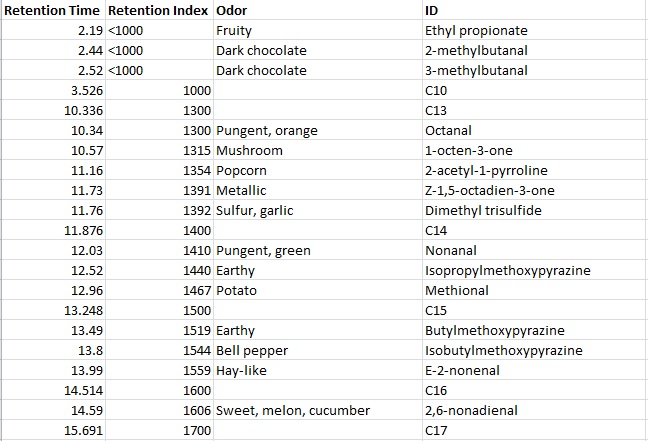By: Bethany Richardson
You might be thinking, “what an odd title for an article,” but it comes from a comment fellow author Thomas Siebertz left on my “Show us your OFG!” post.
The answer?
A sniff port that is used as part of gas chromatography-olfactometry (GC-O).
I work in Dr. Cadwallader’s flavor analysis lab at the University of Illinois and we do just that-analyze flavors. However, our noses are what do most of our work. What we perceive as “flavor” mainly comes from a variety of odor-active compounds that are detected by the olfactory bulb.
When most people think of flavor, they mainly just talk about the overall impact of it, such as banana, chocolate, or garlic. However, there are likely several chemical compounds that work together to create that flavor. Something very complex, such as coffee, could have hundreds!
The basic concept behind the GC-O is the use of a column to separate compounds by size and polarity; some compounds have better resolution with particular types of columns, so at least 2 are used for complete identification. If you have ever used gas chromatography-mass spectrometry (GC-MS), the process is essentially the same; however, the difference is that a human nose acts as the detector instead of the mass spec. This is advantageous because our noses are much more sensitive than the mass spec; many of the compounds in food are at very low concentrations, which makes analytical detection difficult. Furthermore, just because a compound can be detected on GC-MS, it doesn’t necessarily mean that particular chemical is odor active.
When using the GC-O, you record the time, intensity and descriptors of each aroma that you perceive- which is certainly an acquired skill. My MS project is on beets, and I can tell that as I’ve become more comfortable with my sample and the process of GC-O it has become easier to detect and describe the compounds I am smelling. To determine what the compounds are, you use the time that you detected the compound in a formula that compares it to times from known standard alkanes. This value (a retention index) coupled with the odor description, can be compared to a database of flavor compounds (such as http://flavornet.org/flavornet.html) to find a compound that matches. For example, if I smell a compound that smells earthy at a retention index of 1770 on a wax column, it is likely geosmin (one of the major odorants in beets!).

Example of odorant calculations
Not only can the GC-O be used to determine compound identities, it can also be paired with a technique called aroma extract dilution analysis (AEDA) to calculate relative odor intensities. With this method, 1/3 dilutions of the whole aroma extract are sniffed sequentially on GC-O until no odorants are detected. Then a flavor dilution (FD) factor is calculated for each particular compound, based on the last dilution at which that particular odorant is detected. A higher FD factor translates into a higher potency.
I love sharing my research and hope that this article gave you a little bit better understanding into the world of flavor analysis. If you have any further questions I’d be more than happy to answer them!






That was extremely informative Bethany! Are you hoping to achieve anything in particular by characterizing the flavor profile of beets (making artificial beet flavor, identifying an off flavor, etc.) or is it just to build a flavor profile and better understand what chemical compounds are contributing?
Very interesting, thanks for sharing Bethany. At my job we rely on odor to detect decomposition in fish but it’s pretty subjective as results can vary among different inspectors. When we do sensory training we can have a room full of experts who might disagree on whether a product passes or fails. Sometimes it’s very difficult to detect when a product is in the beginning stages of decomposition and every species has a different odor. I wonder if the GC-O can be used for sensory training to calibrate everyone to the same standards? Love the title by the way!
If you used it with a type of extraction called SPME (solid phase microextration) because your off-odor compounds are probably very volatile, it might be useful. However, the system is pretty expensive, which is why they aren’t very common in industry.
I’d like to know that
1. How could you identify character impact compounds in each food?
2.FD factor vs OAV which one is more reliable for character impact compounds